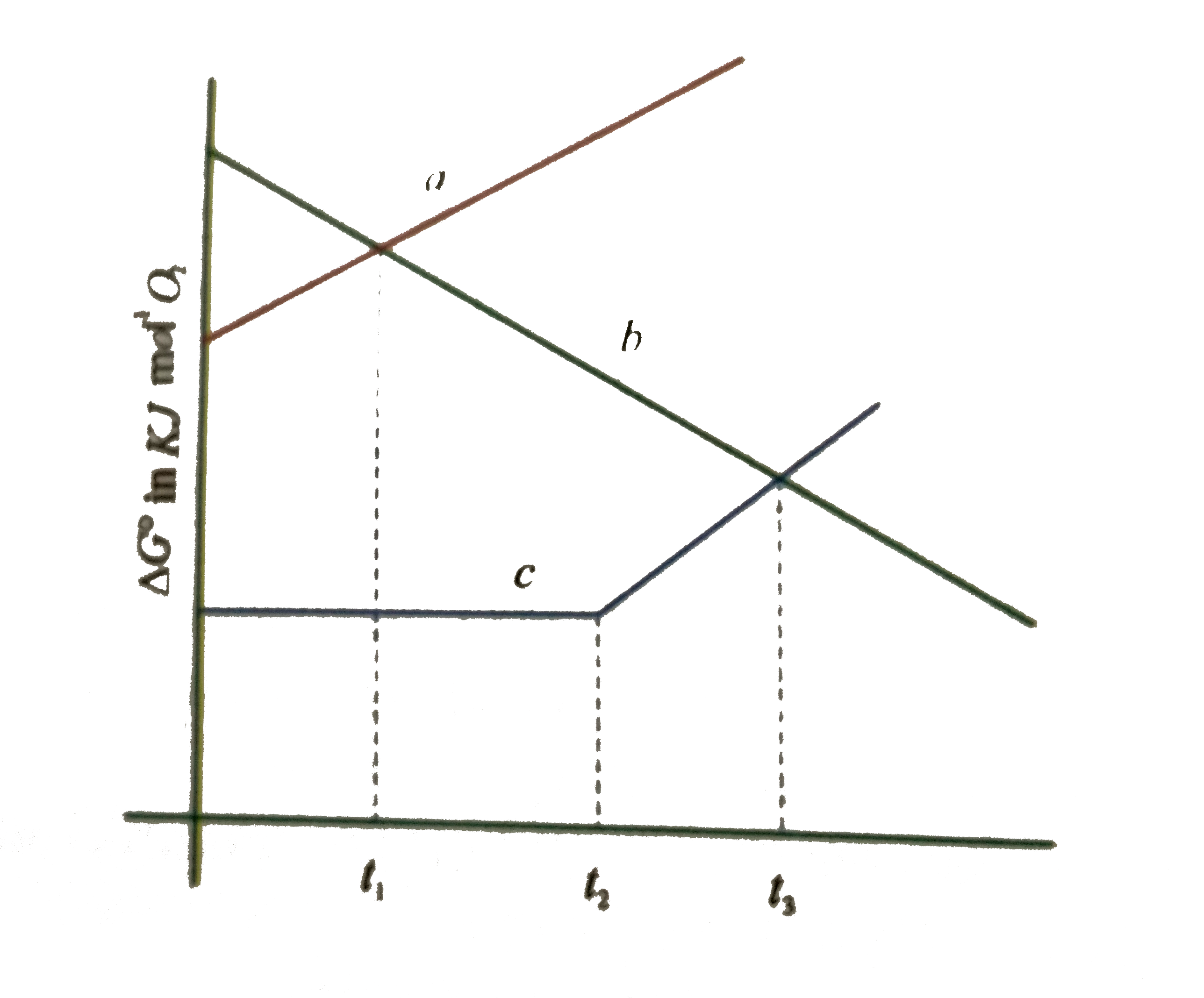Temperature range used for the reduction of FeO by overall effect of the given reactions is related to which points shown in the adjacent graph.
(i) C+O2→CO2 (ii) 2C+O2→2CO (iii) 2CO+O2→2CO2
point A
point B
point D
point E
The correct Answer is:B, D
Topper's Solved these Questions
- GENERAL PRINCIPLES AND PROCESSES OF ISOLATION OF ELEMENTSBOOK - CHHAYA PUBLICATIONCHAPTER - GENERAL PRINCIPLES AND PROCESSES OF ISOLATION OF ELEMENTSEXERCISE - SOLVED NCERT EXEMPLAR PROBLEMS (Short Answer Type)
18 Videos
- GENERAL PRINCIPLES AND PROCESSES OF ISOLATION OF ELEMENTSBOOK - CHHAYA PUBLICATIONCHAPTER - GENERAL PRINCIPLES AND PROCESSES OF ISOLATION OF ELEMENTSEXERCISE - SOLVED NCERT EXEMPLAR PROBLEMS (Matching Type)
9 Videos
- GENERAL PRINCIPLES AND PROCESSES OF ISOLATION OF ELEMENTSBOOK - CHHAYA PUBLICATIONCHAPTER - GENERAL PRINCIPLES AND PROCESSES OF ISOLATION OF ELEMENTSEXERCISE - SOLVED NCERT EXEMPLAR PROBLEMS
12 Videos
- EQUILIBRIUMBOOK - CHHAYA PUBLICATIONCHAPTER - EQUILIBRIUMEXERCISE - PRACTICE TEST 7
14 Videos
- HALOAKANES AND HALOARENESBOOK - CHHAYA PUBLICATIONCHAPTER - HALOAKANES AND HALOARENESEXERCISE - Practise set 10 (Answer the following questions)
10 Videos
Similar Questions
At the temperature corresponding to which of the points in Fig. FeO will be reduced to Fe by coupling the reaction 2Fe→2Fe+O2 with all of the following reactions?
(a) C+O2→CO2 (b) 2C+O2→2CO and (c) 2CO+O2→2CO2
View SolutionFor which one of the following reaction,the graph of ΔG against T is almost horizontal to temperature axis
(А) C(s) + O2(g) → CO2(g)
(В) 2C(s) + O2(g) → 2CO(g)
(с) 2CO(s) + O2(g) → 2CO2(g)
(D) 2Mg(s) + O2(g) → 2MgO(s)
View Solution
Knowledge Check
Enthalpy for the reaction C+O2→CO2 is
APositiveBNegativeCZeroDNoneFrom Elligham diagram the correct statements
(a) 4cu+O2→2Cu2O
(b)2C+O2→2CO
( c)2Zn+O2→2ZnO
 AAt temeperature above t01C "Carbon" can reduce Cu2OBAt temeperature above t03C "Carbon" can reduce ZnOCReduction of Cu2O with carbon requires high temperature when compared with the reduction of ZnO by carbonDAll
AAt temeperature above t01C "Carbon" can reduce Cu2OBAt temeperature above t03C "Carbon" can reduce ZnOCReduction of Cu2O with carbon requires high temperature when compared with the reduction of ZnO by carbonDAllFrom Elligham diagram the correct statements
(a) 4cu+O2→2Cu2O
(b)2C+O2→2CO
( c)2Zn+O2→2ZnO
 AAt temeperature above t01C "Carbon" can reduce Cu2OBAt temeperature above t03C "Carbon" can reduce ZnOCReduction of Cu2O with carbon requires high temperature when compared with the reduction of ZnO by carbonDAll
AAt temeperature above t01C "Carbon" can reduce Cu2OBAt temeperature above t03C "Carbon" can reduce ZnOCReduction of Cu2O with carbon requires high temperature when compared with the reduction of ZnO by carbonDAll
Calculate the standard enthalpy of reaction for the following reaction using the listed enthalpies of reaction :
3Co(s)+2O2(g)→Co3O4(s)
2Co(s)+O2(g)→2CoO(s), ΔH∘1=−475.8kJ
6CoO(s)+O2(g)→2Co3O4(s),ΔH∘2=−355.0kJ
View SolutionAt the temperature corresponding to which of the points in Fig. FeO will be reduced to Fe by coupling the reaction 2Fe→2Fe+O2 with all of the following reactions?
(a) C+O2→CO2 (b) 2C+O2→2CO and (c) 2CO+O2→2CO2
View SolutionFor the reaction,
C+O2→CO2,ΔH=−393J
2Zn+O2→2ZnO,H=−412J
View SolutionCalculate the standard enthalpy of reaction for the following reaction using the listed enthalpies of reaction :
3Co(s)+2O2(g)→Co3O4(s)
2Co(s)+O2(g)→2CoO(s), ΔH∘1=−475.8kJ
6CoO(s)+O2(g)→2Co3O4(s),ΔH∘2=−355.0kJ
View SolutionC+O2→CO2,
CO+12O2→CO2,
Then ΔfH forCO will be
View Solution
